Last updated: April 22, 2024
Did you know that the Friesian horse once carried medieval knights into battle? These horses, originating from the lush fields of Friesland in the Netherlands, have survived the tides of history and flourished into one of the most beloved breeds in the equestrian world today.
Famous for their elegance, strength, and intelligence, Friesians continue to capture the hearts of horse enthusiasts around the globe. Whether gracefully trotting in a dressage competition or pulling a royal carriage, the Friesian horse breed is a living testament to the enduring bond between humans and horses.
Join us as we explore the world of Friesian horses, the rich tapestry of their history, the striking beauty of their physical features, and their versatile roles in modern equestrian pursuits.
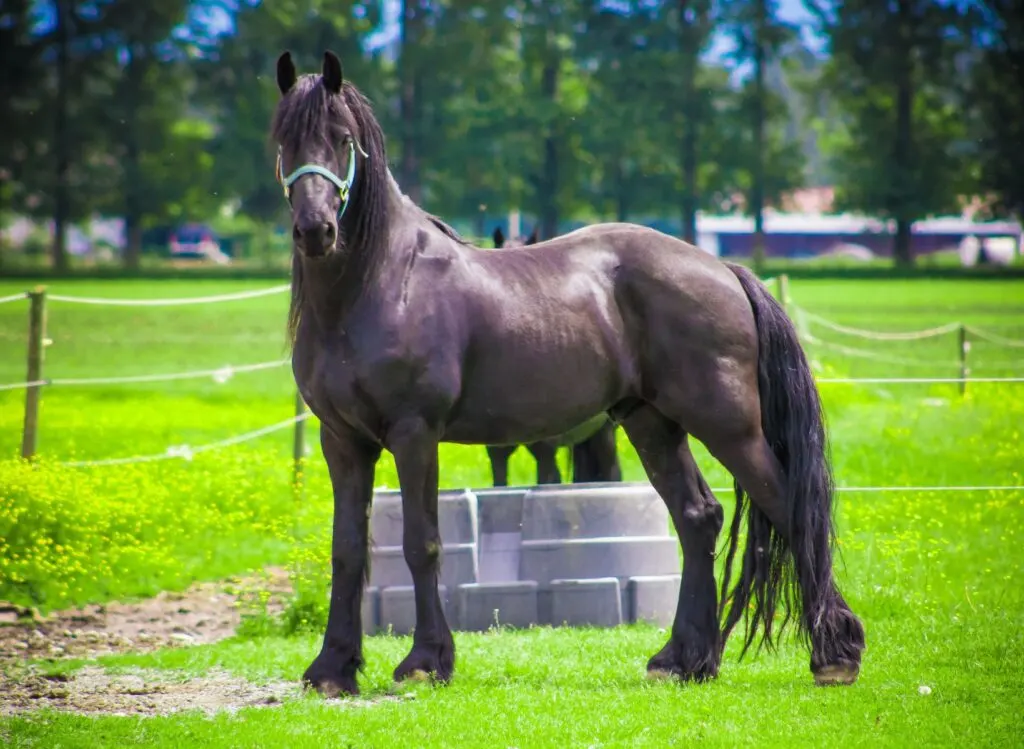
The Historical Journey of Friesian Horses: Their Royal Heritage
Friesian horses, one of Europe’s oldest breeds, originated from Friesland. They served as war horses for medieval knights, where they were relied on for their strength and endurance in battle.
As the eras changed, so did the roles of the Friesian horse; they transitioned from battlefields to royal carriages, symbolizing nobility and serving European royalty with grace and power.
Present-Day Elegance and Versatility
- Excellence in Equestrian Disciplines: Today, the Friesian horse captivates and excels in the equestrian world. They demonstrate versatility and elegance in dressage arenas, show jumping courses, and driving competitions.
- Cultural Icons: Beyond competitive fields, Friesians enchant audiences in films and cultural events. Their majestic appearances make them beloved stars in parades and cinematic productions.
Commitment to Preservation
- Dedicated Breeding: The beauty and unique characteristics of the Friesian horses result from centuries of dedicated breeding efforts to preserve their distinctive traits.
- Global Admiration: These efforts have maintained the breed’s historical qualities and ensured that Friesians continue to be admired and loved worldwide for their aesthetic beauty and adaptable, gentle nature.
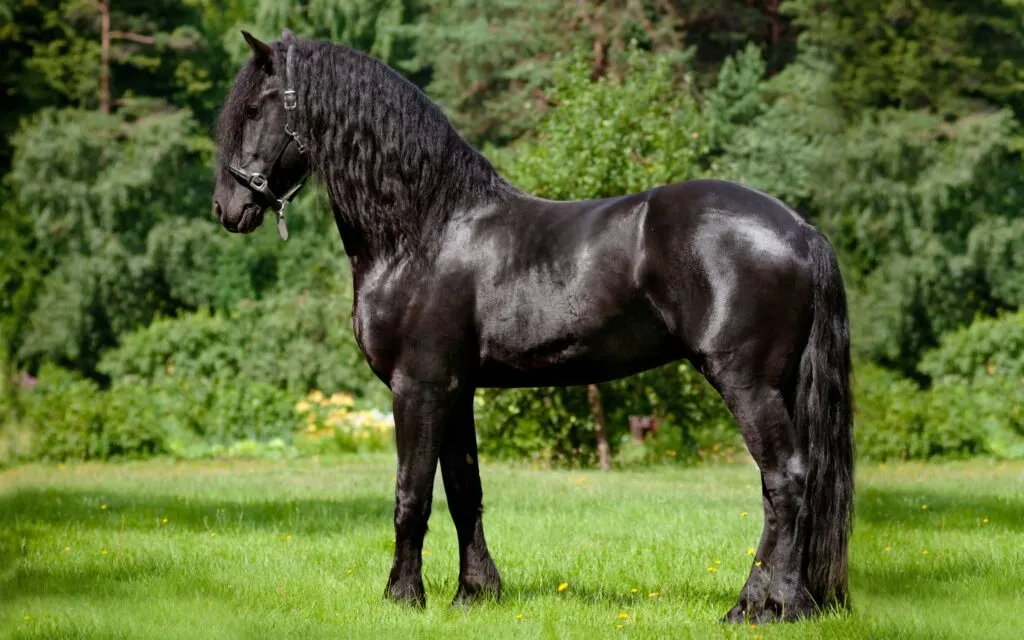
Unique Physical Traits and Temperament of Friesian Horses
In this section, we explore the distinctive physical features and agreeable temperaments that distinguish the Friesian horse breed.
Physical Characteristics
Friesians are instantly recognizable due to their unique physical traits:
- Coat and Appearance: The signature all-black coat, luxurious, flowing mane, tail, and distinctive leg feathering give Friesians their majestic profile. More about their coat and appearance can be learned at Horse Racing Sense.
- Body Structure: With compact, muscular builds, Friesians typically stand about 15.3 hands (63 inches, 160 cm) tall. Their pronounced arched necks highlight their strength and agility.
- Movement: Known for their brisk, high-stepping trot, Friesians display both vigor and grace in their movements.
Conformation Types
Friesians are primarily divided into two types:
- The traditional ‘Baroque’ type features a solid, robust build.
- The ‘Sport Horse’ type is recognized for its sleeker, more refined bone structure. Discover more about these differences at Horse Racing Sense.
For a detailed look at Friesian physical characteristics, refer to the FEI’s detailed breed profile.
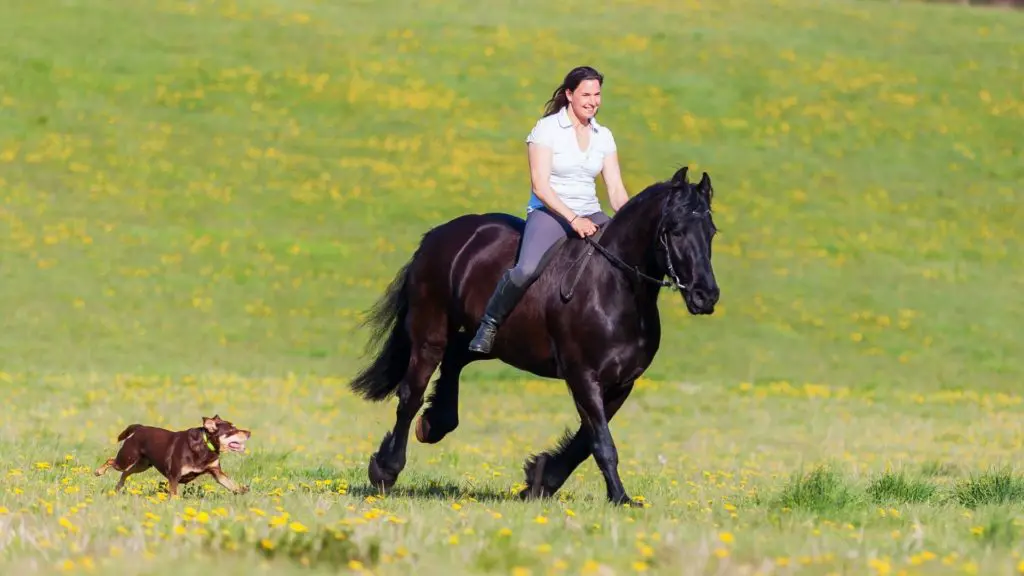
Behavior and Temperament
- General Temperament: Friesians are known for their gentle demeanor, making them ideal for riders of all levels. Their intelligence and eagerness to please facilitate excellent training outcomes.
- Social and Affectionate: Friesians excel in social settings, easily bonding with humans and other horses, which enhances their suitability for family and group activities.
- Genetic Influence: Research, such as that by Professor Paul McGreevy, highlights the role of genetics in their behavior, underlining the importance of understanding these factors for effective training and care. Read more.
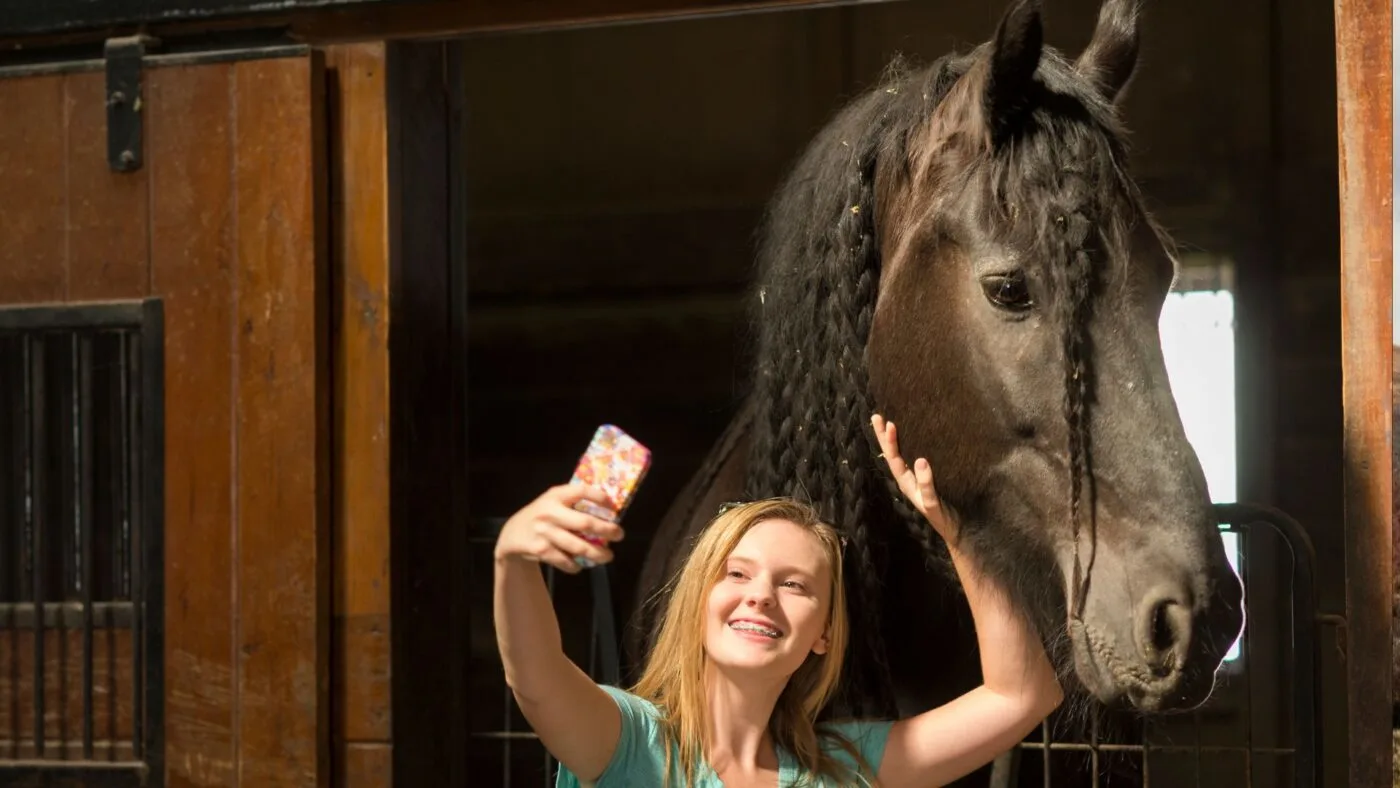
Comprehensive Care Guidelines for Friesian Horses
Caring for a Friesian horse is a dedicated practice that enriches the bond between horse and owner. This breed thrives with attentive management tailored to their specific needs.
Diet and Nutrition
- Grazing Habits: Friesians should graze freely throughout the day, which mimics their natural feeding behavior.
- Quality Feed: Always provide access to fresh, mold-free hay and grass. Clean, fresh water must be available at all times.
- Essential Micronutrients: To ensure your horse receives all its nutrients, include a salt lick or mineral block in their diet.
Housing and Accommodation
- Temperature Management: Given their origin in cooler climates, implement shade and cooling strategies such as fans or misting systems to manage heat stress during warmer months.
- Shelter Requirements: Maintain a clean, safe stall that protects against elements and allows comfortable movement. Ensure the outdoor area is secure and spacious enough for exercise and relaxation.
- Water and Weather Considerations: Modify housing with the changing seasons to ensure continuous comfort and access to fresh water.
Grooming and Health Care
- Routine Grooming: Regularly brush their long manes and tails to maintain coat health and appearance.
- Hoof and Dental Care: Schedule hoof trimming every 6 to 8 weeks and regular dental checkups to prevent issues before they start.
Observing and Understanding
- Regular Exercise: Adequate physical activity is crucial for their well-being, matching their energy and capacity.
- Veterinary Check-ups: Frequent veterinary visits are essential for early detection and management of potential health issues.
- Personalized Care: Understand and cater to your Friesian’s needs, acknowledging their unique personality and requirements.
Caring for a Friesian horse takes effort, but I find it rewarding to see horses thrive, and I think you will, too. Source: Anderson, Alyssa. “What to Know About the Friesian Horse.” WebMD, 9 January 2023. Read the full article
Buying and Owning a Friesian Horse
I advise prospective horse owners to clearly understand their breeding goals, costs, and the specific care requirements of the breed. This knowledge is crucial, especially for such a distinctive breed as Friesians.
Understanding Breeding Goals
- Market Considerations: It’s important to align breeding goals with market demands to ensure the offspring’s relevance and desirability. Allison Thomas emphasizes the importance of market understanding.
- Breed Characteristics: Familiarity with the traits prioritized by Friesian breeders helps buyers select horses that meet their expectations and needs.
Cost Considerations
- Initial Investment: Friesians’ purchase price varies with lineage, training, and age. Consider ongoing care costs as well.
- Long-Term Commitment: Commit to the extensive care needs of Friesians, including grooming, nutrition, exercise, and regular health check-ups.
Finding the Right Match
- Personal Compatibility: Ensure the horse’s temperament and capabilities align with your riding intentions.
- Professional Guidance: Consulting with experienced Friesian owners, breeders, or equine professionals can lead to better purchase decisions.
Owning a Friesian is a financial investment and a lifestyle choice that requires informed decision-making and commitment. But with proper preparation, I think you’ll find the experience worth the investment.
Citations:
- Thomas, Allison. “The Friesian: Identifying Your Breeding Goals”.
- Boerma, S., Back, W., Sloet van Oldruitenborgh-Oosterbaan, M. M. “The Friesian horse breed: Clinical problems and genetic basis”.
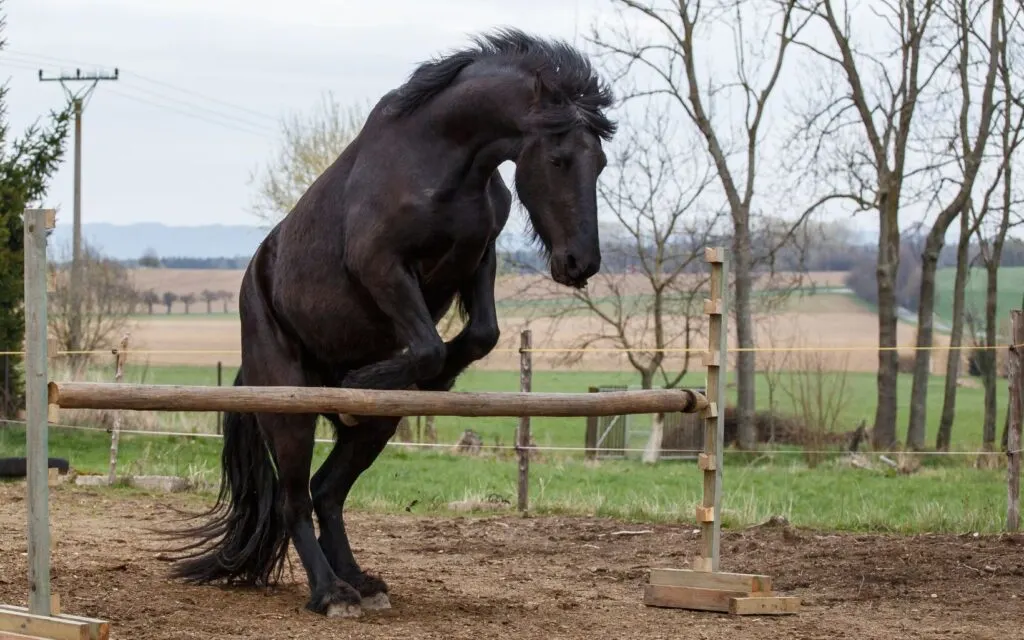
Showcasing Versatility: Friesian Horses in Equestrian Sports
Friesians showcase remarkable versatility and grace in various equestrian disciplines. Here’s how they stand out in the competitive arena:
Equestrian Excellence:
- Dressage Mastery: Known for their agility and strength, Friesians excel in dressage, where their elegant movements and cooperative nature shine.
- Show Jumping and Driving: They also compete in show jumping and driving competitions, demonstrating their versatility and robust athleticism.
- Therapeutic Riding: With a calm demeanor and a willingness to please, Friesians are particularly suited for therapeutic riding programs, providing essential emotional and physical support to riders of all skill levels.
Friesian horses bring their unique blend of beauty, strength, and gentleness to each of these disciplines, making them beloved and respected in the equestrian world.
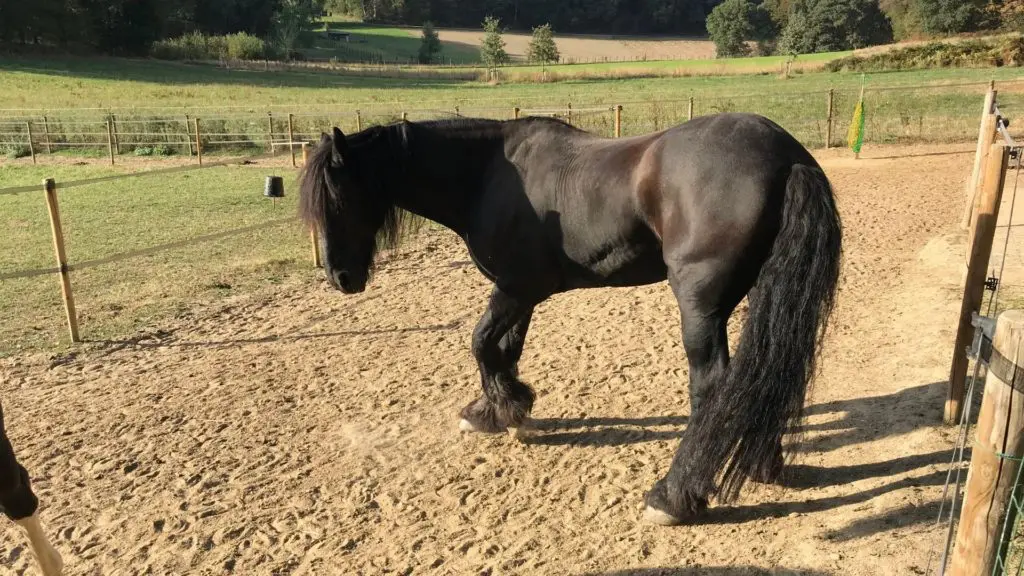
Addressing Genetic Health Challenges in Friesian Horses
Friesians face specific genetic health challenges that necessitate vigilant care and regular veterinary monitoring. Notably:
- Hydrocephalus Prevalence: This condition, characterized by an accumulation of fluid in the brain, is more common in Friesians and requires careful monitoring.
- Aortic Rupture Risk: The breed has a heightened risk of aortic ruptures, a serious cardiovascular concern that demands proactive management.
- Importance of Genetic Research: Continuous research, including studies like those by Astri Olivia Herlino, is essential for understanding these genetic predispositions to improve health outcomes.
Conservation and Breeding: Knowledge of these health risks is vital for responsible breeding practices. Efforts to preserve the breed and reduce the prevalence of these genetic disorders are ongoing, ensuring the health and longevity of Friesians globally.
For further details, refer to Genomic Analysis of Hydrocephalus in Friesian Horses by Astri Olivia Herlino and Friesian horses as a possible model for human acquired aortopulmonary fistulation. Link to study
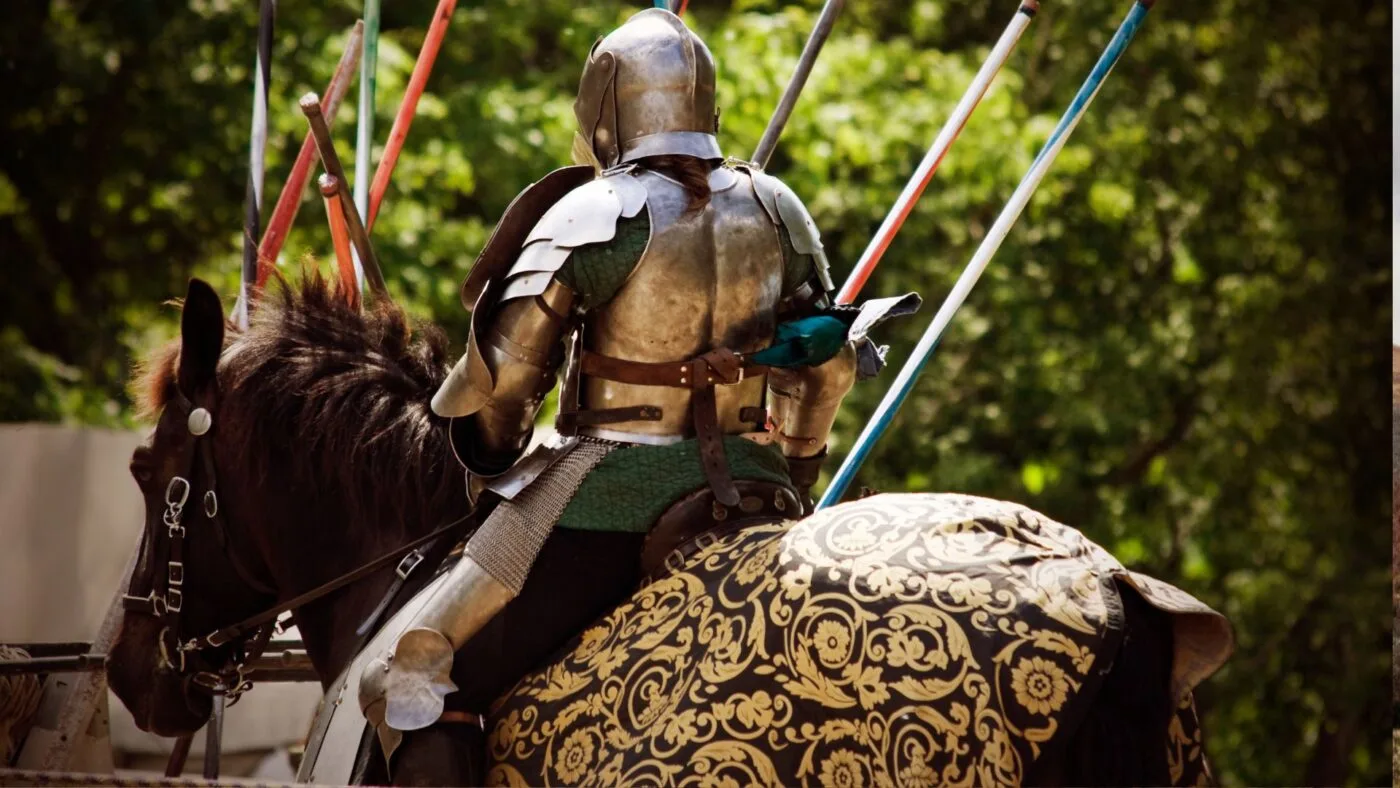
Friesian Horses in Culture and Media
Friesian horses have long been revered in culture and media for their striking appearance and graceful demeanor, capturing the hearts of horse enthusiasts and the wider public.
Symbolism in History and Art
- Regal Depictions: Friesians are historically depicted as symbols of nobility and strength, frequently associated with knights and royalty in art and literature.
- Cultural Icon: Celebrated in their native Friesland and throughout the Netherlands, Friesians represent regional heritage and equestrian tradition, embodying a pivotal aspect of local culture.
Film and Television
- Cinematic Favorites: Known for their dramatic black coats and elegant movements, Friesians are favored in historical and fantasy films.
- Notable Appearances: Their majestic presence enhances the visual storytelling in productions like “Ladyhawke” and “Game of Thrones,” contributing significantly to the cinematic experience.
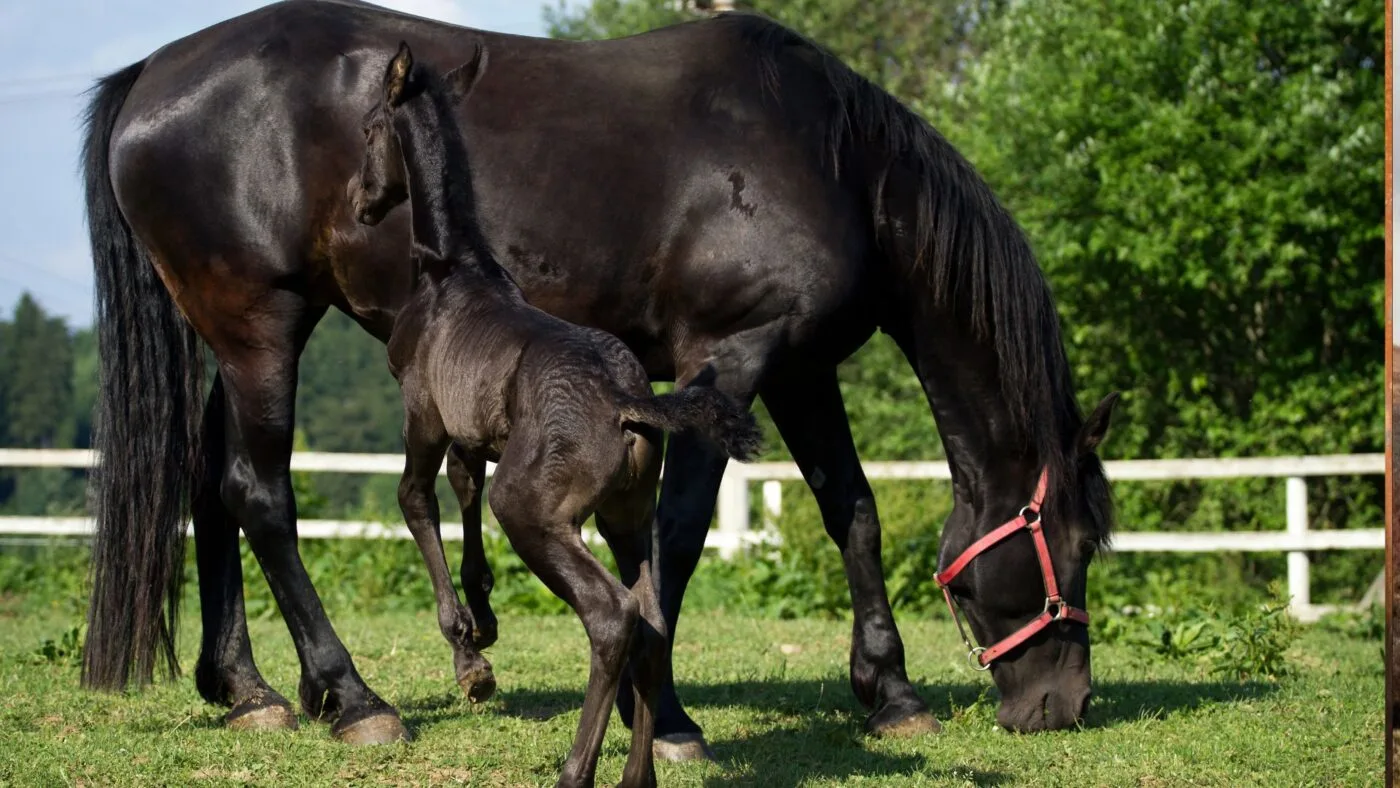
Advertising and Promotions
- Brand Ambassadors: Frequently featured in advertising, Friesians convey luxury and elegance, making them ideal representatives for brands that value beauty and grace.
- Photography and Art: Their photogenic nature makes Friesians popular subjects in equine photography and art, celebrated for their aesthetic appeal.
Public Events and Shows
- Parades and Ceremonies: Friesians captivate audiences in parades and ceremonial events with their regal bearing and poise.
- Equestrian Shows: At equestrian shows and exhibitions, they showcase their skills and the profound bond they share with their handlers, further solidifying their status as stars of the equine world.
In every aspect of culture and media, Friesians exemplify beauty, elegance, and a deep connection with human history and imagination, continuing to enchant and inspire across generations.
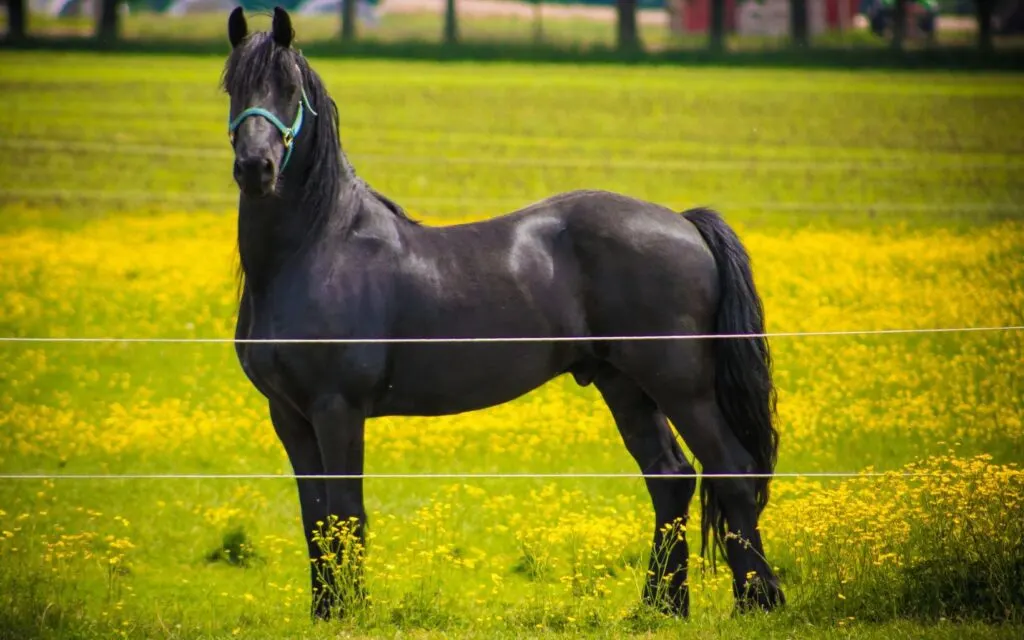
FAQs about Friesian Horses
Are Friesian horses suitable for beginners?
Friesians are known for their gentle temperament, making them suitable for beginners. However, matching the horse’s training level with the rider’s experience is important.
What are the common uses of Friesian horses?
Friesians are used in various equestrian activities, for example they excel in dressage, carriage driving, show jumping, recreational riding, and are also used in therapeutic riding programs.
How much does a Friesian horse cost?
The cost can vary widely based on factors like age, pedigree, and training. Expect initial costs for purchase and care to be significant.
What special care do Friesian horses require?
Friesians require regular grooming, a balanced diet, routine exercise, and health check-ups, with special attention to their long manes and tails.
How long do Friesian horses live?
Friesians enjoy a lifespan of 25 to 30 years, benefiting significantly from regular grooming and meticulous attention to their diet, teeth, and hooves. For insights into their care needs, visit Horse Racing Sense.

Conclusion: Final Thoughts on the Friesian Horse Breed
Friesian horses are well known for their beauty and versatility, enriching the lives of riders and enthusiasts across the globe. Their storied history and prominent role in equestrian sports make owning a Friesian a rewarding experience. The supportive community surrounding this breed provides plentiful opportunities for engagement and enrichment.
Engage with the Community
I encourage all Friesian horse enthusiasts to connect with associations and participate in events to fully immerse themselves in the breed’s rich legacy. These organizations offer essential resources and support, helping to preserve and promote the heritage of the Friesian horse:
- Join Associations: Become part of a vibrant community by joining local or national Friesian horse associations, where you can access valuable resources and support.
- Attend Events: Discover the elegance of Friesian horses firsthand at shows, competitions, and exhibitions.
- Explore Ownership: If you’re considering owning a Friesian, consult with reputable breeders or equine professionals to ensure a perfect match.
Connect and Share
We value your stories and experiences with Friesian horses. Share them in the comments or send an email to [email protected]. Together, we can celebrate and sustain the legacy of this magnificent horse breed.
Resources and Further Engagement
For additional details, connect with the following associations, each dedicated to various aspects of Friesian horse care, breeding, and promotion:
- Friesian Horse Association of North America (FHANA): Visit FHANA
- The Friesian Horse Society (FHS): Visit FHS
- Koninklijke Vereniging “Het Friesch Paarden-Stamboek” (KFPS): Visit KFPS
- International Friesian Show Horse Association (IFSHA): Visit IFSHA
- Friesian Horse Association of Great Britain & Ireland (FHAGBI): Visit FHAGBI
These platforms offer excellent opportunities to learn, share your passion, and connect with others who appreciate the unique qualities of Friesian horses.
Interested in learning more about other fascinating horse breeds? Dive deeper with our Guide to Horse Breeds for more detailed insights.
